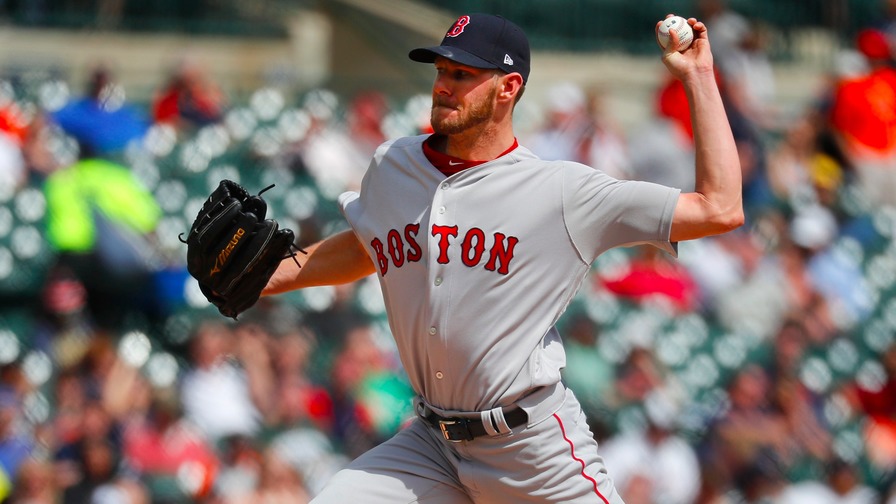Chris Sale Is Back and Nastier Than Ever

If you're a fantasy geek like me, you're well aware of the incredible first six weeks Chris Sale has registered as a member of his new team, the Boston Red Sox. But if maybe you focus primarily on NL-only leagues, or just live under a rock, Sale's start to 2017 has been pretty incredible.
But don't think that fantasy baseball owners aren't skeptical of this start -- we have short memories, and aren't likely to forget his 2016 numbers which were good, but not the Sale we were accustomed to.
So, how good has Sale really been, and what's driving this performance? Is it for real, or is he likely to fall off some time soon?
Chris Sale's 6th straight game with 10 K. Pedro MartÃnez is the only other player with a streak of 6+ games in Red Sox history. pic.twitter.com/LdrF3d0BAA
— ESPN Stats & Info (@ESPNStatsInfo) May 7, 2017
Let's dig in and find out.
Breaking Down Sale's Absurdity
There are only so many superlatives one can throw out there to quantify the nastiness of Sale. He logged a career-high 226 2/3 innings last year, but his 3.43 SIERA wasn't too Sale-ian, as was his 25.7% strikeout rate -- although that was still rather strong.
That's not what fantasy baseball owners paid a premium for, though.
Traded to Boston this offseason, he's turned everything on its head. Take a quick glance at the league-leading starting pitchers in terms of SIERA and a few other metrics.
| Name | Innings | SIERA | K Rate % | K-BB Rate % |
|---|---|---|---|---|
| Chris Sale | 51.2 | 2.17 | 37.6% | 32.0% |
| Michael Pineda | 34.2 | 2.45 | 31.2% | 27.5% |
| Luis Severino | 39.2 | 2.73 | 29.2% | 24.7% |
| Clayton Kershaw | 48.2 | 2.84 | 28.0% | 24.3% |
| Max Scherzer | 40.2 | 2.92 | 28.9% | 25.3% |
Sale hasn't just been really good -- he's been the best in nearly every measurable we can identify while leading the way in innings pitched. So, those fantastic numbers are even more important to overall category ratios for season-long leagues.
He's certainly gone through multiple dominant stretches, and this qualifies as one of them. He's been the most valuable and most dominant starter in the league so far. And it's not even close.
Speed Kills
To say Sale struggled in 2016 wouldn't be accurate -- he was still pretty damn good, but did record a noticeable dip in strikeouts that coincided with a drop in fastball velocity.
Using information from Brooks Baseball, we can see the difference in his four-seam fastball velocity since the start of the 2015 season.

Now, it's difficult to pinpoint exactly what changed with Sale, but certainly something was different. A deeper dive over the same time period reveals that his swing-and-miss rate against lefties from 2016 to 2017 hasn't changed much. And while it's up against right-handed batters, Sale's dominance cannot be solely attributed to this newfound pace.

So, what's been different?
A Change in Pitch Mix
Analyzing Sale's pitch mix over the last three years reveals a fairly obvious change in approach. Below is the raw pitch data as a percentage of total pitches thrown during this period.
| Pitch Type | 2015 | 2016 | 2017 |
|---|---|---|---|
| Four seam | 40.7% | 45.3% | 33.6% |
| Sinker | 12.0% | 15.6% | 15.2% |
| Slider | 19.7% | 25.0% | 28.5% |
| Change | 27.6% | 14.1% | 22.7% |
In 2016, which coincided with a dip in both strikeout rate and swinging-strike rate (11.3% in 2016, his lowest mark since 2013), 60.9% of Sale's pitches were either four-seamers or sinking fastballs. In 2017, while still early, that mark is roughly 48.8% -- meaning he's traded about 12.0% of his pitch mix from fastballs to his secondary offerings.
That's important to note, as Sale currently boasts a swinging-strike rate of 16.5%, easily a career best.
In comparing the outcomes of those pitches, it's really easy to see why Sale is enjoying so much success. While his four-seam fastball is pretty tough to hit in terms of average, the results off his slider and change are clearly show they're the toughest pitches for opposing hitters to face.

Conclusion
Chris Sale seems to enjoy his new digs quite a bit -- the bizarre jersey blowup last year just made it a matter of time before he was escorted out of town, and the change of scenery did him some good.
At first blush, it would be easy to conclude that he's throwing harder, which is leading to better numbers -- and that certainly is part of the equation. It appears, though, that the bigger driver of Sale's success is a concerted effort to change his pitch mix. Throwing significantly more sliders and changeups, even only in six weeks in, is fueling his growth as a starter.
Sale hasn't just been good -- he's been dominant, and every advanced metric would indicate this performance is for real. He's not only flashing signs of vintage Sale, but is also on the way to his best campaign yet. And despite a negative park factor shift to the second-most hitter-friendly park over the last three seasons, it hasn't made much of an impact.
If you're a Sale owner, be happy -- and if you can find a way to trade for him, do it now. His pitching WAR (2.4) is already almost a win better than the second- (James Paxton -- 1.7) and third-most valuable pitchers (Jason Vargas -- 1.4) this year. Strike now if you can before the price gets even more exorbitant.
















